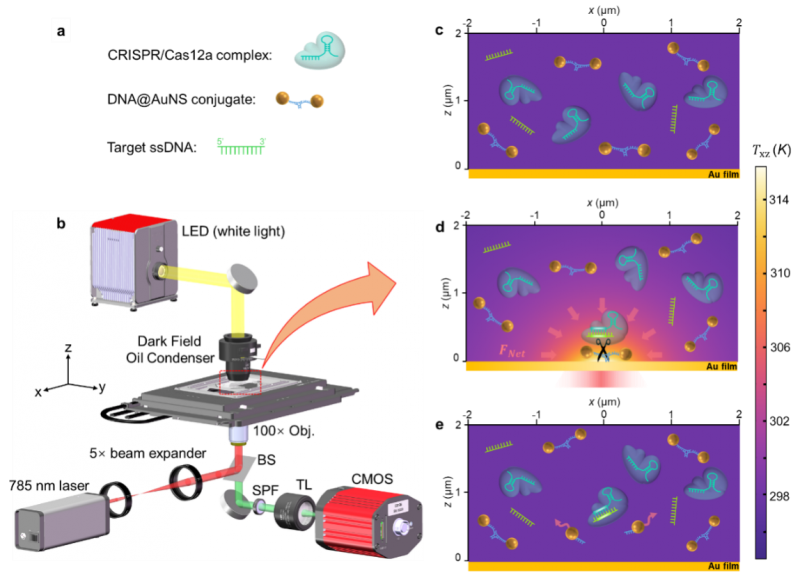By effectively capturing a wider spectrum of nanoparticles, optothermal nanotweezers - an optical manipulation tool developed over the past ten years - have revolutionized classical optical manipulation.

Working principle of the CRONT. Image Credit: Light: Science Array Applications
Although in-situ modification of nanoparticles has been the principal use of this technology, its potential for bio-nanoparticle identification is yet largely untapped. Here, authors created CRISPR-powered optothermal nanotweezers (CRONT) based on the synergistic effects of optothermal manipulation and CRIPSR-based bio-detection.
In particular, the authors were able to trap and enrich bio-nanoparticles, such as gold nanoparticles, CRISPR-associated proteins, and DNA molecules, by making use of diffusiophoresis and thermo-osmotic fluxes close to the substrate upon optothermal activation.
A group of researchers headed by Professor Jiajie Chen, Zhi Chen, Zhang Han, and Yonghong Shao from Shenzhen University, as well as their collaborator Professor Ho-Pui Ho from The Chinese University of Hong Kong, have developed an optothermal method for improving CRISPR-based single-nucleotide polymorphism (SNP) detection to achieve single molecule level. The study was published in Light Science & Application.
Moreover, they have presented a new CRISPR technique for nucleotide cleavage observation. This novel method has given optical tweezers the hitherto impossible capacity to identify DNA in aqueous solution. It is positioned to become a ubiquitous tool in point-of-care diagnosis, biophotonics, and bionanotechnology due to its exceptional specificity and feasibility for in-situ manipulation and detection of bio-nanoparticles.
To control bionanoparticles and match the requirements for CRISPR-based target bionanoparticle identification, the CRONT can be finely tweaked. Incorporating optothermal induced diffusiophoretic force, the researchers effectively manipulated various bio-nanoparticles, including ssDNA, dsDNA, BSA, Cas12a protein, and DNA-functionalized gold nanoparticles.
Employing a CRISPR-based DNA biosensing method, where they investigated the cleavage of a single trapped DNA@Gold-nanoparticle conjugate, they transformed this optothermal tweezer into a molecular probe for identifying in-situ DNA molecules (such as SARS-CoV-2 or Monkeypox) without nucleic acid amplification. Remarkably, they achieved detection limits of 25 aM for ssDNA and 250 aM for dsDNA through this approach.
Their demonstration showcases the nanotweezers' capability to identify single nucleotide polymorphisms (SNPs) within an incredibly small detection volume (10 μL). SNPs are pivotal in genetic diversity and correlate with numerous phenotypic traits, such as disease susceptibility and drug response.
Consequently, this breakthrough in SNP detection techniques holds immense significance, catering to the diverse requirements of genomic research and future medical applications.
These authors summarized the Work and Outlook of the CRONT as follows:
“CRONT has enabled the immediate implementation of CRISPR-based biosensing within ultra-low detection volume. Optical tweezers are now endowed with DNA identification ability through the CRISPR-based biosensing system. The localized heating properties of CRONT has provided not only an avenue for biomolecule enrichment but also a necessary thermal environment necessary for the cleavage of CRISPR complex.”
They added, “Further development of this optothermal based CRISPR bio-detection scheme may involve the utilization of an array of laser heating spots for parallel high-throughput detection, which makes the technique more suitable for quantitative detection and significantly reducing detection time. CRONT may also be employed to guide the CRIPSR/Cas complex to the target DNA and initiate the gene editing process. It also allows the researchers to monitor the gene editing process in real time at the single molecule level.”
The authors concluded, “We anticipate that such non-contact nanoprobes will contribute to a deeper understanding of various complex biological processes, high lighting optical, thermal, biological similarities at the single-particle level.”
Journal Reference
Chen, J., et al. (2023). CRISPR-powered optothermal nanotweezers: Diverse bio-nanoparticle manipulation and single nucleotide identification. Light Science & Application. doi.org/10.1038/s41377-023-01326-9